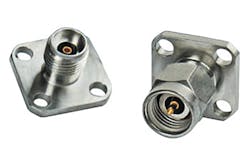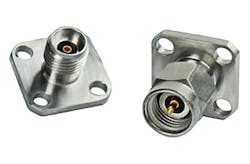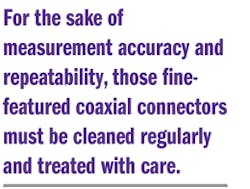Get a Grip on Those MM-Wave Connectors
Of course, mm-wave components and systems must be tested, and leading test-equipment suppliers have been responding over the past year with some excellent products for the price. For users to get the full value of mm-wave test equipment, they must bear in mind that as frequencies go higher, component dimensions get smaller. This is particularly true of the broadband-but-minute coaxial test connectors that interconnect to a device under test (DUT), and these must be treated with kindness to extract the greatest value from mm-wave test equipment.
For those who may recall the evolution of coaxial connectors towards mm-wave frequencies—including the development of the “K” (2.92-mm) connector by Bill Oldfield at Anritsu when it was still known as Wiltron Co., or the work of Julius Botka at Hewlett-Packard Co. before it became known as Agilent Technologies and then Keysight Technologies, or Mario Maury at Maury Microwave—the chase for higher frequencies with coaxial connectors has been on for several decades. There has always been a certain blend of mechanical engineering and magic involved in realizing connectors capable of operating with low forward loss and minimal reflections at frequencies past 60 GHz.
Although not approaching the dimensions of semiconductors, fabrication of mm-wave connectors with their fine metal structures and the air spacings necessary for low-loss electrical performance at those wavelengths is an impressive achievement in itself. For test equipment and measurement applications, such connectors must not simply be secured once in a “set-and-forget” hookup, but must survive thousands of connect-and-disconnect operations; they must maintain tight phase and amplitude characteristics within the limits required by the test equipment and measurements.
Working at mm-wave frequencies requires a special kind of attention to detail, whether in circuit design, fabrication, or in testing. Not that mm-wave testing is about to become routine or commonplace overnight, but the use of mm-wave frequencies is growing steadily. Signal frequencies at 60 GHz and beyond are being used or planned for use in such applications as automotive safety (collision-avoidance) systems and backhaul links for coming Fifth-Generation (5G) cellular communications systems. The components within those systems and the systems themselves will require development and production testing, which will put regular stress on those small-featured coaxial connectors.
For the sake of measurement accuracy and repeatability, those fine-featured coaxial connectors must be cleaned regularly and treated with care. They are oft-overlooked components in a test instrument, but the connectors are as important as any other component in a test signal source or analyzer—especially at these higher test frequencies. Those early K and V connectors enabled coaxial connections to 60 GHz and beyond for vector network analyzers (VNAs), providing new insights into components and devices at those higher frequencies. Years later, coaxial connectors are being counted upon to make mm-wave production-line components (that have been tested) possible. With proper care, those connectors can be long-term, repeatable, and reliable parts of mm-wave test system solutions.
About the Author
Jack Browne Blog
Jack Browne, Technical Contributor, has worked in technical publishing for over 30 years. He managed the content and production of three technical journals while at the American Institute of Physics, including Medical Physics and the Journal of Vacuum Science & Technology. He has been a Publisher and Editor for Penton Media, started the firm’s Wireless Symposium & Exhibition trade show in 1993, and currently serves as Technical Contributor for that company's Microwaves & RF magazine. Browne, who holds a BS in Mathematics from City College of New York and BA degrees in English and Philosophy from Fordham University, is a member of the IEEE.



